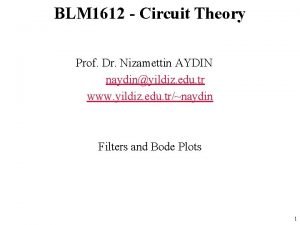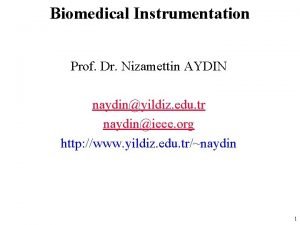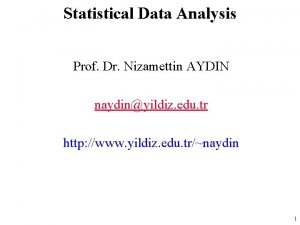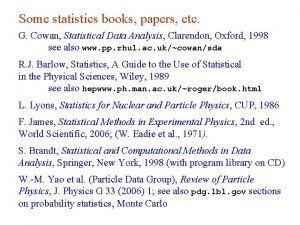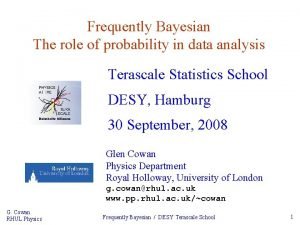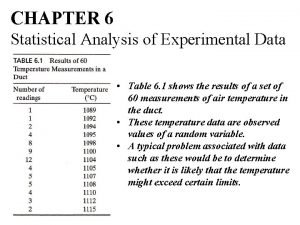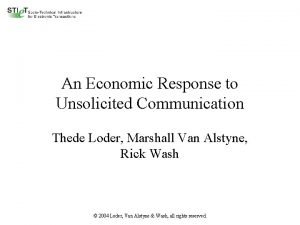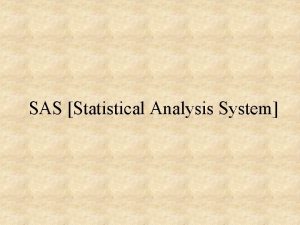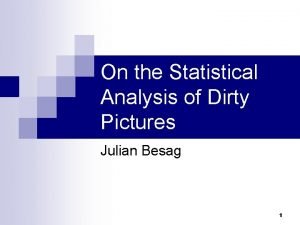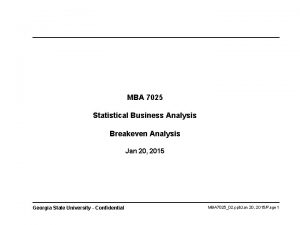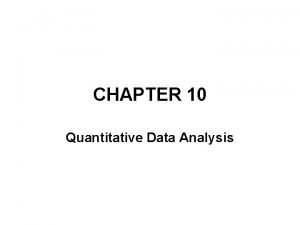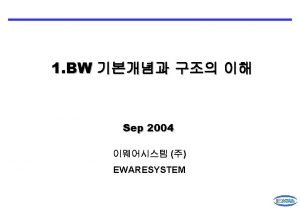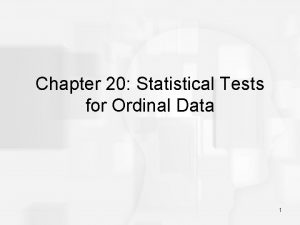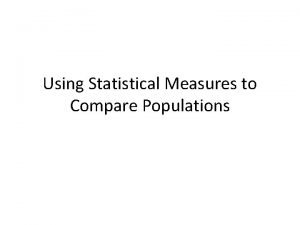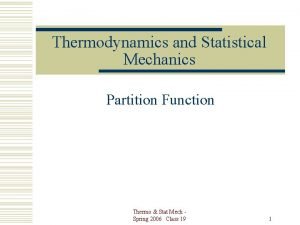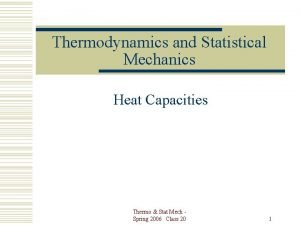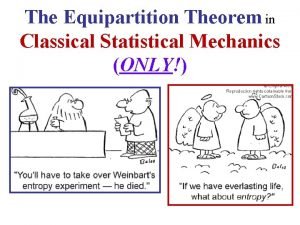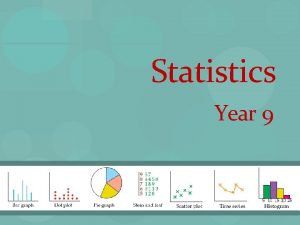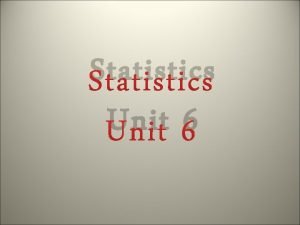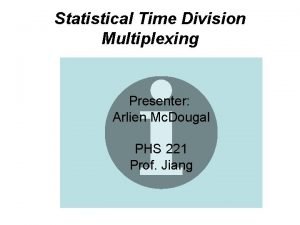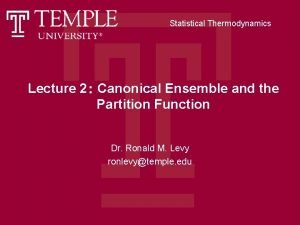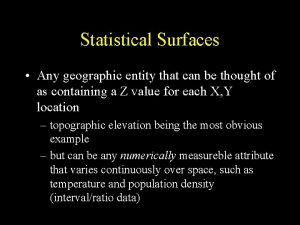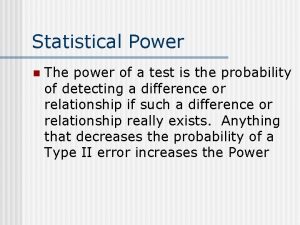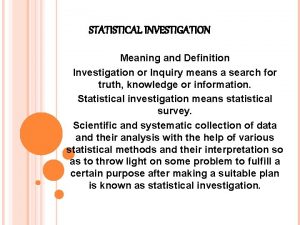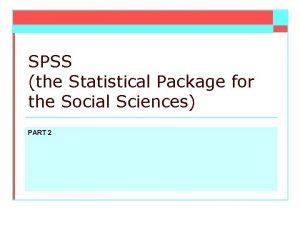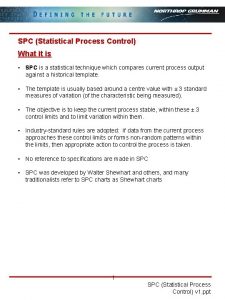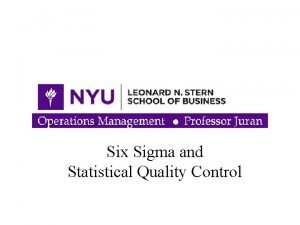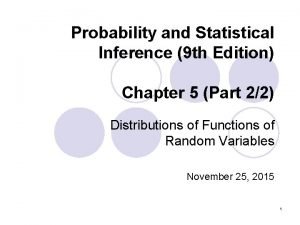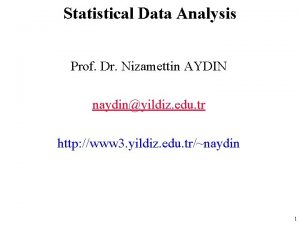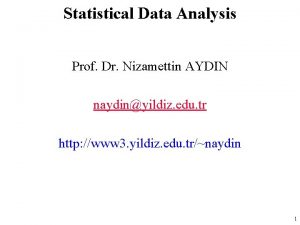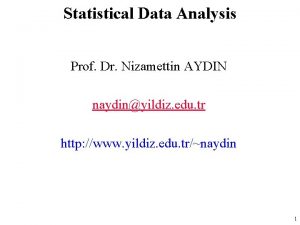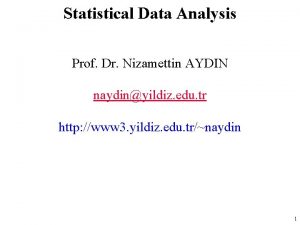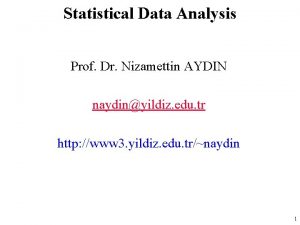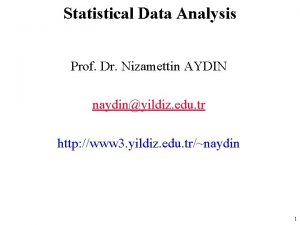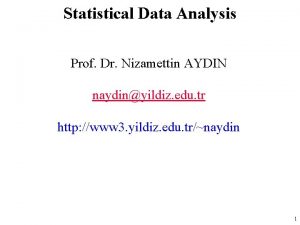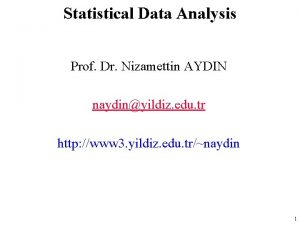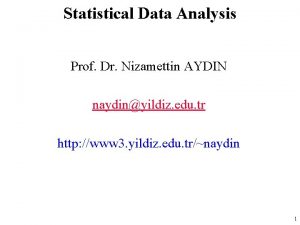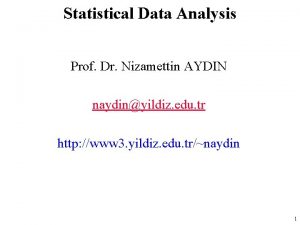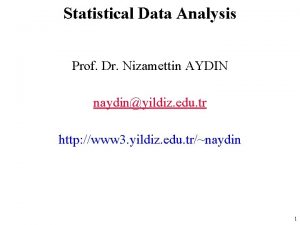Statistical Data Analysis Prof Dr Nizamettin AYDIN naydinyildiz
























































- Slides: 56

Statistical Data Analysis Prof. Dr. Nizamettin AYDIN naydin@yildiz. edu. tr http: //www 3. yildiz. edu. tr/~naydin 1

Estimation 2

Parameter Estimation • The objective of statistics is to make inferences about a population based on information contained in a sample. • Populations are characterized by numerical descriptive measures called parameters. • Typical population parameters are the mean m, the median M, the standard deviation s, and a proportion p. • Most inferential problems can be formulated as an inference about one or more parameters of a population. 3

Parameter Estimation • Methods for making inferences about parameters fall into one of two categories: – estimate the value of the population parameter of interest – test a hypothesis about the value of the parameter • These two methods of statistical inference involve different procedures, and they answer two different questions about the parameter: – In estimating a population parameter, we are answering the question • “What is the value of the population parameter? ” – In testing a hypothesis, we are seeking an answer to the question • “Does the population parameter satisfy a specified condition? ” 4

Parameter Estimation • We discussed – using random variables to represent characteristics of a population • (e. g. , BMI, disease status). – some commonly used probability distributions for discrete and continuous random variables. • We are specifically interested in population mean and population variance of a random variable. – These quantities are unknown in general. • We refer to these unknown quantities as parameters. • Here, we use parameters μ and σ2 to denote the unknown population mean and variance respectively. – Note that for all the distributions we discussed previously, the population mean and variance of a random variable are related to the unknown parameters of probability distribution assumed for that random variable. • Indeed, for normal distributions N(μ, σ2), which are widely used in statistics, the population mean and variance are exactly the same parameters used to specify the distribution. 5

Parameter Estimation • In this lecture, we discuss statistical methods for parameter estimation. – Estimation refers to the process of guessing the unknown value of a parameter (e. g. , population mean) using the observed data. • For this, we will use an estimator, which is a statistic. – A statistic is a function of the observed data only. • Sometimes we only provide a single value as our estimate. – This is called point estimation. • Point estimates do not reflect our uncertainty when estimating a parameter. • We always remain uncertain regarding the true value of the parameter when we estimate it using a sample from the population. • To address this issue, we can present our estimates in terms of a range of possible values. – This is called interval estimation. 6

Convention • We use X 1, X 2, . . . , Xn to denote n possible values of X obtained from a sample randomly selected from the population. • We treat X 1, X 2, . . . , Xn themselves as n random variables because their values can change depending on which n individuals we sample. • We assume the samples are independent and identically distributed (IID). • While theoretically we can have many different samples of size n, we usually have only one such sample in practice. • We use x 1, x 2, . . . , xn as the specific set of values we have observed in our sample. • That is, x 1 is the observed value for X 1, x 2 is the observed value X 2, and so forth. 7

Point estimation - Population Mean • 8

Point estimation - Population Mean • *Mackowiak, P. A. , Wasserman, S. S. , Levine, M. M. : A critical appraisal of 98. 6°F, the upper limit of the normal body temperature, and other legacies of Carl Reinhold August. Wunderlich. JAMA 268, 1578– 1580 (1992) 9

Law of Large Numbers (LLN) • 10

Law of Large Numbers (LLN) • 11

Law of Large Numbers (LLN) • 12

Point estimation - Population Variance • 13

Point estimation - Population Variance • 14

Point estimation - Population Variance • 15

Sampling distribution • 16

Sampling distribution • 17

Sampling distribution • 18

Sampling distribution • 19

Sampling distribution • 20

Sampling distribution • 21

Sampling distribution • We can simulate the procedure using R-Commander. – Click Distributions → Continuous distributions → Normal distribution → Sample from normal distribution. – Then enter 125 for the mean, 15 for standard deviation. – Set the Number of samples (rows) to 1000 and the Number of observations (columns) to 100, as in the figure. • This creates 1000 different samples, where the size of each sample is n = 100. – Keep the option Sample means checked; • this will store the sample means in a variable called mean. 22

Sampling distribution • We can now plot the histogram of the 1000 sample means. (Normal. Samples should be the active data set. ) • Click Graphs → Histograms; choose mean as the Variable in Data tab and check Densities in Options tab. 23

Sampling distribution 24

Confidence Intervals for the Population Mean • It is common to express our point estimate along with its standard deviation to show much the estimate could vary if different members of population were selected as our sample. • Alternatively, we can use the point estimate and its standard deviation to express our estimate as a range (interval) of possible values for the unknown parameter. 25

Confidence Intervals for the Population Mean • 26

Confidence Intervals for the Population Mean • 27

Confidence Intervals for the Population Mean • 28

Confidence Intervals for the Population Mean • Theoretically, we could repeatedly sample n = 100 people, find the sample mean, and determine the interval. • Then, the true population mean μ would fall within these intervals with probability 0. 95. • Suppose, for example, that we repeated this process 20 times to obtain 20 such intervals, as shown in the figure. • In this figure, each sample mean is shown as a circle and the true (but unknown) population mean μ = 125 as the dashed vertical line. • Of 20 intervals, 19 (i. e. , 95%) cover the true mean. 29

Confidence Intervals for the Population Mean • 30

Confidence Intervals for the Population Mean • 31

Confidence Intervals for the Population Mean • 32

Confidence Intervals for the Population Mean • However, we are 95% confident that it belongs to the former set of intervals and includes the true value of the population mean. • The 95% confidence refers to our degree of confidence in the procedure that generated this interval. • If we could repeat this procedure many times, 95% of intervals it creates would include the true population mean. 33

Confidence Intervals for the Population Mean • 34

Confidence Intervals for the Population Mean • 35

z-critical Values • 36

z-critical Values • Suppose that we want to set the confidence level of our interval estimate for the population mean to 0. 8. • To find the corresponding multiplier, we need to find the number of units we need to move from 0 on each side so that the probability of the resulting interval becomes 0. 8 based on the standard normal distribution. • The next figure shows the probability density curve of N(0, 1), which is known as the Z-curve. 37

z-critical Values • The shaded area is 0. 8, – which is the probability of the corresponding interval on the x axis. • The upper end of this interval is shown as z. – Here, z is the number of units we need to move away from 0 so that the probability of the resulting interval is 0. 8. • That is, z is the multiplier needed to use to obtain 80% confidence intervals for population mean 38

z-critical Values • Since the total area under the curve is 1, the unshaded area is 1 − 0. 8 = 0. 2. • Because of the symmetry of the curve around the mean, the two unshaded areas on the left and the right of the plot are equal, – which means that the unshaded area on the righthand side is 0. 2/2 = 0. 1. • Therefore, the upper-tail probability of z is 0. 1, – which is equal to (1 − 0. 8)/2. 39

z-critical Values • 40

z-critical Values • 41

z-critical Values • We can follow similar steps to find the z-critical values for any other confidence level. • For example, for 0. 9 confidence level, zcrit = 1. 64. • For 0. 95 confidence level, so far we have been using zcrit = 2. • Following the above steps, you will find that a more accurate value is zcrit = 1. 96, which is sometimes used instead of 2 to be more precise. 42

Standard error • 43

Confidence Interval When the Population Variance is Unknown • 44

Confidence Interval When the Population Variance is Unknown Example • 45

Confidence Interval When the Population Variance is Unknown Example • Suppose that we want to find the 90% confidence interval for the population mean, μ. • Then, using the t-distribution with 7− 1 = 6 degrees of freedom, we need to find the tcritical value, tcrit, whose upper tail probability is (1− 0. 9)/2 = 0. 05. • In R-Commander, – click Distributions → Continuous distributions → t distribution → t quantiles. – Set the Probabilities to 0. 05, the Degrees of Freedom to 6, and check Upper tail option. 46

Confidence Interval When the Population Variance is Unknown Example • 47

Confidence Interval When the Population Variance is Unknown Example • In this example, if we knew σ = 2. 2 instead of estimating it to be s = 2. 2, – we would have used zcrit = 1. 64 instead of tcrit = 1. 94, and the interval would have been smaller. • Everything else the same, using t-distribution instead of the standard normal leads to wider intervals. – This is the price we pay for the additional uncertainty due to the estimation of population variance (and SD) from the data. • The t-distribution approaches the standard normal distribution as the sample size increases (i. e. , the degree of freedom increase). – Therefore, the difference between the z-critical values and the t-critical values becomes negligible for very large sample sizes. 48

Using Central Limit Theorem for Confidence Interval • 49

Confidence Intervals for the Population Proportion • 50

Confidence Intervals for the Population Proportion –Example- • 51

Confidence Intervals for the Population Proportion –Example- • From the above confidence interval, we can find the confidence interval for the number of smoking pregnant women in the US during 1986. • Supposing that there are currently N = 4 million pregnant women in the US, • we find the 95% confidence interval for the number of smoking pregnant women as follows: [0. 33× 4000000, 0. 45× 4000000] = [1320000, 1800000] 52

Margin of Error • For the above example, we can write the 95% CI for the population proportion of women who smoke during their pregnancy as follows: 0. 39± 2× 0. 03. • In this case, the term 2 × SE = 2 × 0. 03 = 0. 06 is called the margin of error for 0. 95 confidence level. • In general, it is common to present interval estimates for c confidence level as Point estimate± Margin of error 53

Margin of Error • 54

Sample Size Estimation • 55

Sample Size Estimation • 56
 Prof. dr. nizamettin aydin
Prof. dr. nizamettin aydin Nizamettin aydin
Nizamettin aydin Prof. dr. nizamettin aydin
Prof. dr. nizamettin aydin Prof. dr. nizamettin aydin
Prof. dr. nizamettin aydin Nizamettin aydin
Nizamettin aydin Nizamettin aydin
Nizamettin aydin Giga tera
Giga tera Preserving statistical validity in adaptive data analysis
Preserving statistical validity in adaptive data analysis Cowan statistical data analysis
Cowan statistical data analysis Cowan statistical data analysis pdf
Cowan statistical data analysis pdf Statistical analysis of experimental data
Statistical analysis of experimental data Sinan aydın ymm
Sinan aydın ymm Aydın kendirci
Aydın kendirci Unsent message to aydin
Unsent message to aydin Sevil aydın
Sevil aydın Aydın bir türk kadınıyım
Aydın bir türk kadınıyım Bushra hasan
Bushra hasan Organization
Organization Aydin marine
Aydin marine Aydın başar
Aydın başar Nazmi aydın
Nazmi aydın Aydin bal
Aydin bal Aydın kekemelik merkezi
Aydın kekemelik merkezi Statistical analysis system
Statistical analysis system Ascenex
Ascenex Multivariate statistical analysis
Multivariate statistical analysis Statistical business analysis
Statistical business analysis Marketing analytics software r
Marketing analytics software r Data collection in research example
Data collection in research example What statistical test for categorical data
What statistical test for categorical data Statistical data warehouse
Statistical data warehouse Statistical tests for ordinal data
Statistical tests for ordinal data Statistical treatment
Statistical treatment Content analysis secondary data
Content analysis secondary data Data collection procedure
Data collection procedure Data preparation and basic data analysis
Data preparation and basic data analysis Data acquisition and data analysis
Data acquisition and data analysis Government statistical service graduate scheme
Government statistical service graduate scheme Using statistical measures to compare populations
Using statistical measures to compare populations Stat
Stat Statistical mechanics
Statistical mechanics Equipartition theorem proof
Equipartition theorem proof Statistical displays
Statistical displays What is a statistical question 6th grade
What is a statistical question 6th grade What is statistical time division multiplexing
What is statistical time division multiplexing Statistical thermodynamics is a study of
Statistical thermodynamics is a study of What is microcanonical ensemble
What is microcanonical ensemble Univariate statistical tests
Univariate statistical tests Statistical surfaces
Statistical surfaces Generating alpha meaning
Generating alpha meaning Statistical power table
Statistical power table Statistical natural language processing
Statistical natural language processing Statical investigation
Statical investigation Statistical package for social sciences
Statistical package for social sciences Statistical process control ppt
Statistical process control ppt Statistical symbols and meanings
Statistical symbols and meanings Chebyshev's inequality
Chebyshev's inequality


